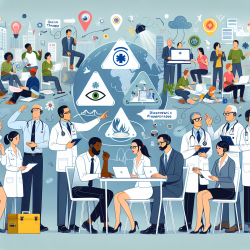Introduction: Bridging Optics and Speech-Language Pathology
In the realm of speech-language pathology, data-driven decisions are pivotal for crafting effective therapeutic interventions. While optics and speech-language pathology may seem worlds apart, the innovative research on "Dielectric Optical-Controllable Magnifying Lens by Nonlinear Negative Refraction" offers intriguing parallels that can inspire practitioners to enhance their skills and outcomes for children.
Understanding the Research: A Brief Overview
The study explores a novel dielectric magnifying lens that utilizes nonlinear negative refraction through four-wave mixing. This lens, crafted from a thin glass slide, achieves magnification by converting infrared beams into visible ones. The research demonstrates the potential of these lenses in overcoming traditional optical limitations, such as the diffraction limit, which restricts resolution.
Applications in Speech-Language Pathology
While the direct application of optical lenses may not seem immediately relevant to speech-language pathology, the underlying principles of innovation and overcoming limitations can inspire practitioners in several ways:
- Embrace Innovation: Just as the researchers transformed a traditional lens into a magnifying one, speech-language pathologists can explore innovative tools and techniques to enhance therapeutic outcomes. Consider integrating technology, such as teletherapy platforms, to reach a broader audience.
- Overcome Limitations: The research addresses the challenge of diffraction limits in optics. Similarly, practitioners can focus on overcoming barriers in therapy, such as communication challenges or limited resources, by adopting creative strategies and evidence-based practices.
- Data-Driven Approaches: The meticulous design and experimentation in the study underscore the importance of data-driven decisions. Speech-language pathologists can enhance their practice by rigorously analyzing data to tailor interventions to each child's unique needs.
Encouraging Further Research and Collaboration
This groundbreaking research highlights the potential for interdisciplinary collaboration. Speech-language pathologists are encouraged to engage with other fields, such as technology and optics, to explore new methodologies and tools that can improve therapeutic outcomes.
Furthermore, practitioners should consider conducting their own research or participating in studies that investigate the efficacy of innovative interventions. By contributing to the body of knowledge, they can help shape the future of speech-language pathology.
Conclusion: A Call to Action
In conclusion, while the research on nonlinear optical lenses may initially seem unrelated to speech-language pathology, it serves as a powerful reminder of the value of innovation, data-driven decisions, and interdisciplinary collaboration. By adopting these principles, speech-language pathologists can enhance their practice and create better outcomes for children.
To read the original research paper, please follow this link: Dielectric Optical-Controllable Magnifying Lens by Nonlinear Negative Refraction.










